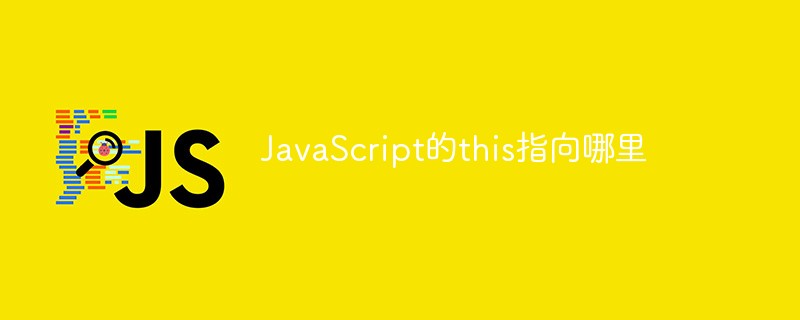JavaScript はどこを指しているのでしょうか?
これは以下を指します: 1. 通常の関数またはオブジェクト属性として、ウィンドウ オブジェクトを指します; 2. イベント バインディング内で、バインドされたイベントの要素を指します; 3. コンストラクター内で、クラスのインスタンス; 4. 矢印 関数では、最も近い親コンテキストで this を指します; 5. call/apply/bind では、渡された最初のパラメーターを指します。

このチュートリアルの動作環境: Windows7 システム、JavaScript バージョン 1.8.5、Dell G3 コンピューター
JavaScript中this次の状況を指します:
- 通常の関数またはオブジェクト属性として
- イベント バインディング
- コンストラクター
- Arrow function
-
call/apply/bindSpecify
一つずつ紹介しましょう
通常の関数またはオブジェクト属性として
this は、メソッドの実行前に「ドット」があるかどうかによって決まります。「ドット」がある場合は、その「ドット」の前にいる人が決まります。 this になります。ドットがない場合、this は window
const fn = function () {
console.log(this);
};
const obj = { name: 'OBJ', fn };
fn();
obj.fn();
const fn1 = obj.fn;
fn1();1. window
2. {name: 'OBJ', fn: function() {console.log(this)}} // obj
3. windowthis は関数を呼び出したオブジェクトを指します。それ以外の場合、その this は window を指します。
イベント バインディング
イベント バインディングを実行する場合、イベント バインディング関数のthis はバインディング イベントの要素です:
// 假设页面中有id为button的button元素
// var x = 100;
window.x = 100;
const fn = function () {
console.log(this.x);
};
const obj = { x: 200, fn };
const $button = document.getElementById('button');
$button.x = 300;
obj.fn();
const fn1 = obj.fn;
fn1();
$button.addEventListener('click', fn);
$button.addEventListener('mouseenter', obj.fn);
$button.addEventListener('mouseleave', function () {obj.fn();});1. 200 2. 100 3. 点击button时:300 4. 鼠标移入button时:300 5. 鼠标移出时:200
this を DOM# にポイントするのに役立ちます。 ## イベントにバインドされた要素。対応するイベントがコードを通じてトリガーされる場合は、call/apply/bind( new Fn#) を通じてその this
$button.click.call() // this为window,打印结果为100
コンストラクターを指定できます。 ##)
) が実行されます。関数内の this は、現在のクラス ( です) のインスタンスです。 new キーワードは、これを行うのに役立ちます:
var x = 100;
const Fn = function () {
this.x = 200;
console.log(this.x);
};
const fn = new Fn();answer:1. 200
arrow function
矢印には独自の ## がありません関数 #this、使用される
this は、最も近い親コンテキスト の this
const fn = function () {
console.log(this);
setTimeout(() => {
console.log(this);
}, 1000);
setTimeout(function () {
console.log(this);
});
};
const obj = { x: 100, fn };
obj.fn();answer:1. {x:100, fn: function() {...}} // obj
2. window
3. {x:100, fn: function() {...}} // obj を変更して、call/apply/bind に渡される最初のパラメータとして
: var x = 100;
const obj = { x: 200, y: 200 };
const fn = function () {
console.log(this.x);
};
fn();
fn.call(obj);
fn.apply(obj);
const fixedThisFn = fn.bind(obj);
fixedThisFn();answer:1. 100 2. 200 3. 200 4. 200
実行時の最初のパラメータは
this- がポイントし、後続のパラメータは
- fn
実行時のパラメータapply実行時、最初のパラメータはthis がポイント, 後続のパラメータは、 - fn
実行時のパラメータで構成される配列です。配列内の各項目は、fnbind ## の各パラメータに対応します。 #実行時、最初のパラメータは事前にthisに渡されたポインタ、以降のパラメータは実際に fn - を呼び出す前に渡されたパラメータで、戻り値はfunction
fixedThisFn、fixedThisFnは内部でfnを呼び出し、そのthisがを指すように指定します。より深い理解call/apply/bindは、関数内でthis が指すものをどのように変更しますか? 以下では、これら 3 つの関数をシミュレートして実装します
call/apply/bindソース コードの実装
前の紹介によると、関数がオブジェクト プロパティとして呼び出されるとき、this は関数を呼び出すオブジェクト const obj = { x: 100, fn () {console.log(this);} };
obj.fn(); // {x: 100, fn: function() {...}} => objログイン後にコピー
JavaScriptconst obj = { x: 100, fn () {console.log(this);} };
obj.fn(); // {x: 100, fn: function() {...}} => obj のこの機能を使用すると、実行された関数を call/ の最初のパラメーター context
を実行し、context を渡します。この属性に対応する関数を呼び出すには、関数の this が context## を指します。 #call ソース コードのシミュレーションは次のとおりです。
Function.prototype.myOwnCall = function (context, ...args) {
const uniqueKey = new Date().getTime();
// this为调用call方法的函数
context[uniqueKey] = this;
// 作为对象的方法被对象调用,this指向该对象context
const result = context[uniqueKey](...args);
delete context[uniqueKey];
return result;
};この時点で、context が call/ に渡されたらどうなるかに気付いた友人もいるかもしれません。 apply はオブジェクトではありませんか?
mdn による call メソッドの最初のパラメーターの説明を見てみましょう:
function.call( thisArg 、 arg1、 arg2、 ...) * thisArg
functionメソッドでこの関数を呼び出します。関数の実行時に使用されるthis
値。thisは、このメソッドで表示される実際の値ではない可能性があることに注意してください。この関数が非厳密モードの場合、
の場合は、nullまたはunknownになります。指定すると、グローバル オブジェクトを指すように自動的に置き換えられ、元の値がラップされます。次に、myOwnCallメソッドの最初のパラメーターを次のように処理します。は、function translateToObject (context) { // 可以通过 == 进行判断 context == null // null == undefined => 2个等号是成立的 // null,undefined => window if (typeof context === 'undefined' || context === null) { context = window; } else if (typeof context === 'number') { // 原始值转换为包装对象 context = new Number(context); } else if (typeof context === 'string') { context = new String(context); } else if (typeof context === 'boolean') { context = new Boolean(context); } return context; }ログイン後にコピー
myOwnCall
Function.prototype.myOwnCall = function (context, ...args) {
context = translateToObject(context);
const uniqueKey = new Date().getTime();
// this为调用call方法的函数
context[uniqueKey] = this;
// 作为对象的方法被对象调用,this指向该对象context
const result = context[uniqueKey](...args);
delete context[uniqueKey];
return result;
};call# と同じです。 ## (2 番目を除く) パラメーターは配列です: <div class="code" style="position:relative; padding:0px; margin:0px;"><pre class='brush:php;toolbar:false;'>Function.prototype.myOwnBind = function (context, paramsArray) {
context = translateToObject(context);
const uniqueKey = new Date().getTime();
// this为调用call方法的函数
context[uniqueKey] = this;
// 作为对象的方法被对象调用,this指向该对象context
const result = context[uniqueKey](...paramsArray);
delete context[uniqueKey];
return result;
};</pre><div class="contentsignin">ログイン後にコピー</div></div><p>相比于<code>call/apply,bind函数并没有立即执行函数,而是预先传入函数执行时的this和参数,并且返回一个函数,在返回的函数中执行调用bind函数并将预先传入的this和参数传入
bind的源码模拟:
Function.prototype.myOwnBind = function (context, ...outerArgs) {
const fn = this;
return function (...innerArgs) {
return fn.call(context, ...outerArgs, ...innerArgs);
};
};精简版如下:
Function.prototype.myOwnBind = (context, ...outerArgs) => (...innerArgs) => this.call(context, ...outerArgs, ...innerArgs);
这里并没有实现通过new操作符来执行fn.bind(context)的操作,如果想知道其详细的实现过程,可以看我的这篇文章: JS进阶-手写bind
在深入理解call/apply/bind的实现原理后,我们尝试完成下面的测试:
function fn1 () {console.log(1);}
function fn2 () {console.log(2);}
fn1.call(fn2);
fn1.call.call(fn2);
Function.prototype.call(fn1);
Function.prototype.call.call(fn1);answer:
1. 1 2. 2 3. 什么都不输出 4. 1
这里我们根据call的源码来进行推导一下Function.prototype.call.call(fn1),其它的执行过程类似:
// 1. 首先会将Function.prototype.call作为一个函数来执行它原型上的call方法 // 所以call方法内部: // this => Function.prototype.call // context => fn1 // 通过对象的属性来执行方法改变this指向 // fn1[uniqueKey] = this(Function.prototype.call) // fn1[uniqueKey]() // 执行 Function.prototype.call方法,但是this是context // 2. 在this为fn1的情况下执行Function.prototype.call方法 // 所以call方法内部: // this => fn1 // context => window // 通过对象的属性来改变this指向 // window[uniqueKey] = fn1 // window[uniqueKey]() // 执行fn1(),但是this是window
更多编程相关知识,请访问:编程入门!!
以上がJavaScript はどこを指しているのでしょうか?の詳細内容です。詳細については、PHP 中国語 Web サイトの他の関連記事を参照してください。

ホットAIツール

Undresser.AI Undress
リアルなヌード写真を作成する AI 搭載アプリ

AI Clothes Remover
写真から衣服を削除するオンライン AI ツール。

Undress AI Tool
脱衣画像を無料で

Clothoff.io
AI衣類リムーバー

Video Face Swap
完全無料の AI 顔交換ツールを使用して、あらゆるビデオの顔を簡単に交換できます。

人気の記事

ホットツール

メモ帳++7.3.1
使いやすく無料のコードエディター

SublimeText3 中国語版
中国語版、とても使いやすい

ゼンドスタジオ 13.0.1
強力な PHP 統合開発環境

ドリームウィーバー CS6
ビジュアル Web 開発ツール

SublimeText3 Mac版
神レベルのコード編集ソフト(SublimeText3)

ホットトピック
 7643
7643
 15
15
 1392
1392
 52
52
 91
91
 11
11
 33
33
 151
151
 WebSocket と JavaScript を使用してオンライン音声認識システムを実装する方法
Dec 17, 2023 pm 02:54 PM
WebSocket と JavaScript を使用してオンライン音声認識システムを実装する方法
Dec 17, 2023 pm 02:54 PM
WebSocket と JavaScript を使用してオンライン音声認識システムを実装する方法 はじめに: 技術の継続的な発展により、音声認識技術は人工知能の分野の重要な部分になりました。 WebSocket と JavaScript をベースとしたオンライン音声認識システムは、低遅延、リアルタイム、クロスプラットフォームという特徴があり、広く使用されるソリューションとなっています。この記事では、WebSocket と JavaScript を使用してオンライン音声認識システムを実装する方法を紹介します。
 WebSocket と JavaScript: リアルタイム監視システムを実装するための主要テクノロジー
Dec 17, 2023 pm 05:30 PM
WebSocket と JavaScript: リアルタイム監視システムを実装するための主要テクノロジー
Dec 17, 2023 pm 05:30 PM
WebSocketとJavaScript:リアルタイム監視システムを実現するためのキーテクノロジー はじめに: インターネット技術の急速な発展に伴い、リアルタイム監視システムは様々な分野で広く利用されています。リアルタイム監視を実現するための重要なテクノロジーの 1 つは、WebSocket と JavaScript の組み合わせです。この記事では、リアルタイム監視システムにおける WebSocket と JavaScript のアプリケーションを紹介し、コード例を示し、その実装原理を詳しく説明します。 1.WebSocketテクノロジー
 JavaScript と WebSocket を使用してリアルタイムのオンライン注文システムを実装する方法
Dec 17, 2023 pm 12:09 PM
JavaScript と WebSocket を使用してリアルタイムのオンライン注文システムを実装する方法
Dec 17, 2023 pm 12:09 PM
JavaScript と WebSocket を使用してリアルタイム オンライン注文システムを実装する方法の紹介: インターネットの普及とテクノロジーの進歩に伴い、ますます多くのレストランがオンライン注文サービスを提供し始めています。リアルタイムのオンライン注文システムを実装するには、JavaScript と WebSocket テクノロジを使用できます。 WebSocket は、TCP プロトコルをベースとした全二重通信プロトコルで、クライアントとサーバー間のリアルタイム双方向通信を実現します。リアルタイムオンラインオーダーシステムにおいて、ユーザーが料理を選択して注文するとき
 WebSocketとJavaScriptを使ったオンライン予約システムの実装方法
Dec 17, 2023 am 09:39 AM
WebSocketとJavaScriptを使ったオンライン予約システムの実装方法
Dec 17, 2023 am 09:39 AM
WebSocket と JavaScript を使用してオンライン予約システムを実装する方法 今日のデジタル時代では、ますます多くの企業やサービスがオンライン予約機能を提供する必要があります。効率的かつリアルタイムのオンライン予約システムを実装することが重要です。この記事では、WebSocket と JavaScript を使用してオンライン予約システムを実装する方法と、具体的なコード例を紹介します。 1. WebSocket とは何ですか? WebSocket は、単一の TCP 接続における全二重方式です。
 JavaScript と WebSocket: 効率的なリアルタイム天気予報システムの構築
Dec 17, 2023 pm 05:13 PM
JavaScript と WebSocket: 効率的なリアルタイム天気予報システムの構築
Dec 17, 2023 pm 05:13 PM
JavaScript と WebSocket: 効率的なリアルタイム天気予報システムの構築 はじめに: 今日、天気予報の精度は日常生活と意思決定にとって非常に重要です。テクノロジーの発展に伴い、リアルタイムで気象データを取得することで、より正確で信頼性の高い天気予報を提供できるようになりました。この記事では、JavaScript と WebSocket テクノロジを使用して効率的なリアルタイム天気予報システムを構築する方法を学びます。この記事では、具体的なコード例を通じて実装プロセスを説明します。私たちは
 簡単な JavaScript チュートリアル: HTTP ステータス コードを取得する方法
Jan 05, 2024 pm 06:08 PM
簡単な JavaScript チュートリアル: HTTP ステータス コードを取得する方法
Jan 05, 2024 pm 06:08 PM
JavaScript チュートリアル: HTTP ステータス コードを取得する方法、特定のコード例が必要です 序文: Web 開発では、サーバーとのデータ対話が頻繁に発生します。サーバーと通信するとき、多くの場合、返された HTTP ステータス コードを取得して操作が成功したかどうかを判断し、さまざまなステータス コードに基づいて対応する処理を実行する必要があります。この記事では、JavaScript を使用して HTTP ステータス コードを取得する方法を説明し、いくつかの実用的なコード例を示します。 XMLHttpRequestの使用
 JavaScriptでinsertBeforeを使用する方法
Nov 24, 2023 am 11:56 AM
JavaScriptでinsertBeforeを使用する方法
Nov 24, 2023 am 11:56 AM
使用法: JavaScript では、insertBefore() メソッドを使用して、DOM ツリーに新しいノードを挿入します。このメソッドには、挿入される新しいノードと参照ノード (つまり、新しいノードが挿入されるノード) の 2 つのパラメータが必要です。
 JavaScript と WebSocket: 効率的なリアルタイム画像処理システムの構築
Dec 17, 2023 am 08:41 AM
JavaScript と WebSocket: 効率的なリアルタイム画像処理システムの構築
Dec 17, 2023 am 08:41 AM
JavaScript は Web 開発で広く使用されているプログラミング言語であり、WebSocket はリアルタイム通信に使用されるネットワーク プロトコルです。 2 つの強力な機能を組み合わせることで、効率的なリアルタイム画像処理システムを構築できます。この記事では、JavaScript と WebSocket を使用してこのシステムを実装する方法と、具体的なコード例を紹介します。まず、リアルタイム画像処理システムの要件と目標を明確にする必要があります。リアルタイムの画像データを収集できるカメラ デバイスがあるとします。




